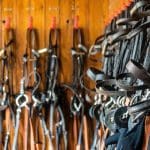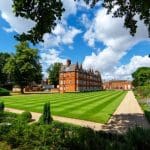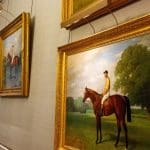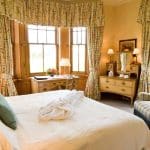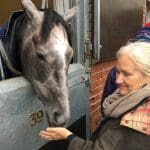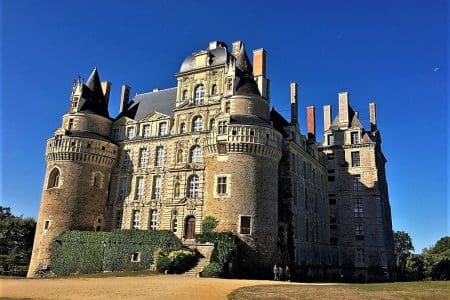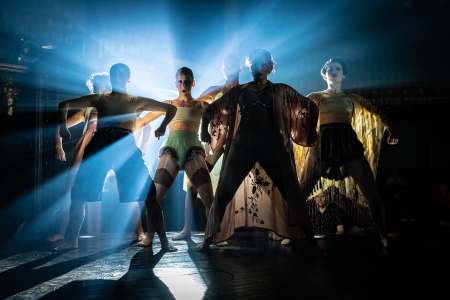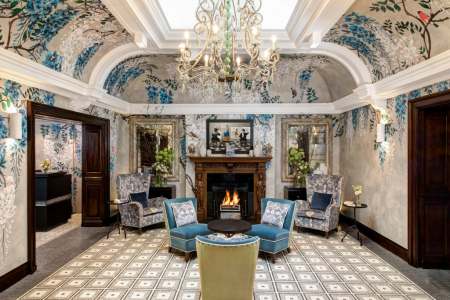Roger Hermiston and Eileen Wise visit Newmarket races in Suffolk and take in the Jockey Club Newmarket, finding it a fascinating excursion.
It was easy to fall for Lyrical. A beautiful, grey thoroughbred, she ambled to the front of her stall and allowed us to stroke her nose before gently nuzzling our hands in appreciation. As friendly and contented an animal as you could wish to meet.
But if Lyrical was hoping for a treat sadly it had to be denied, as just two hours later she would be lining up with eleven other two-year-olds in the 12.20 on Newmarket’s Rowley Mile, in the last meeting of the season. Should we put some money on the filly, we enquired of Scott McGeorge, an engaging host on our visit to trainer Ed Dunlop’s La Grange racing yard? Smiling, he replied cautiously, ‘She was a solid fifth in her last race, so I reckon she’d be worth an each-way bet’.
We sensed – and hoped – that this good-tempered creature would fare well. But we had other equine engagements, so we didn’t arrive at the Newmarket racecourse to start to place our bets until after 1pm. It was our only regret on a splendid day at the home of horseracing that we forgot to back Lyrical – because she came in a plucky third at 33-1.
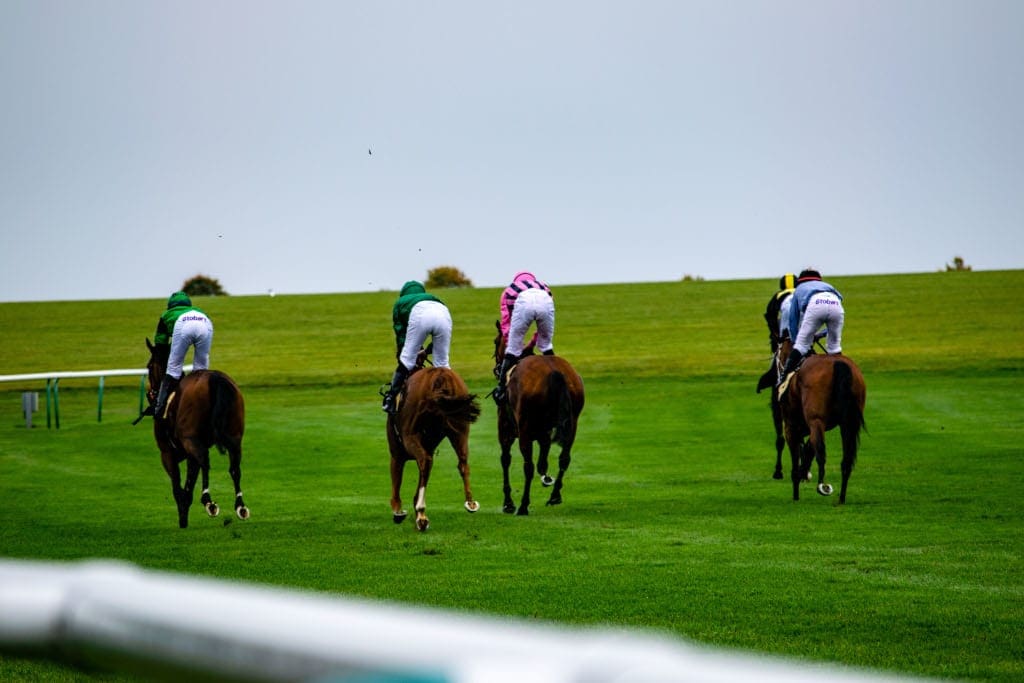
If meeting Lyrical (and friends) at trainer Ed Dunlop’s racing yard was the highlight of our day at the Newmarket races, there was so much else besides. We had chosen to spend a day and a half immersing ourselves in every aspect of the history, culture and practice of the sport of kings.
Newmarket Races Thoroughbred Breakfast Tour
Our equine experience began at 7:30am on a bright, breezy Saturday morning on Warren Hill, for the first leg of our Thoroughbred Breakfast Tour, organised by the town’s excellent official tour guide Discover Newmarket.
We stood on this huge expanse of ground – which has been a training ground for horses for nearly five hundred years – and looked on as groups of sleek racing machines cantered uphill on the artificial Polytrack (a mix of sand, recycled synthetics and rubber) on the busiest racehorse gallops in Britain. There are 81 trainers and over 3,000 racehorses at Newmarket racecourse – it’s been estimated that one in three jobs in and around the town are related to the racehorse industry, which generates over £250 million a year for the local economy.
As the early morning sun rose on the horizon and a light mist wreathed the air, the sight of these top-class athletes – man and beast – bestriding the landscape in harmony was quite magical. It was an equally vibrant auditory experience, with the thundering of the hooves and the snorting and blowing of the animals echoing in the ears as they were put through their strides.
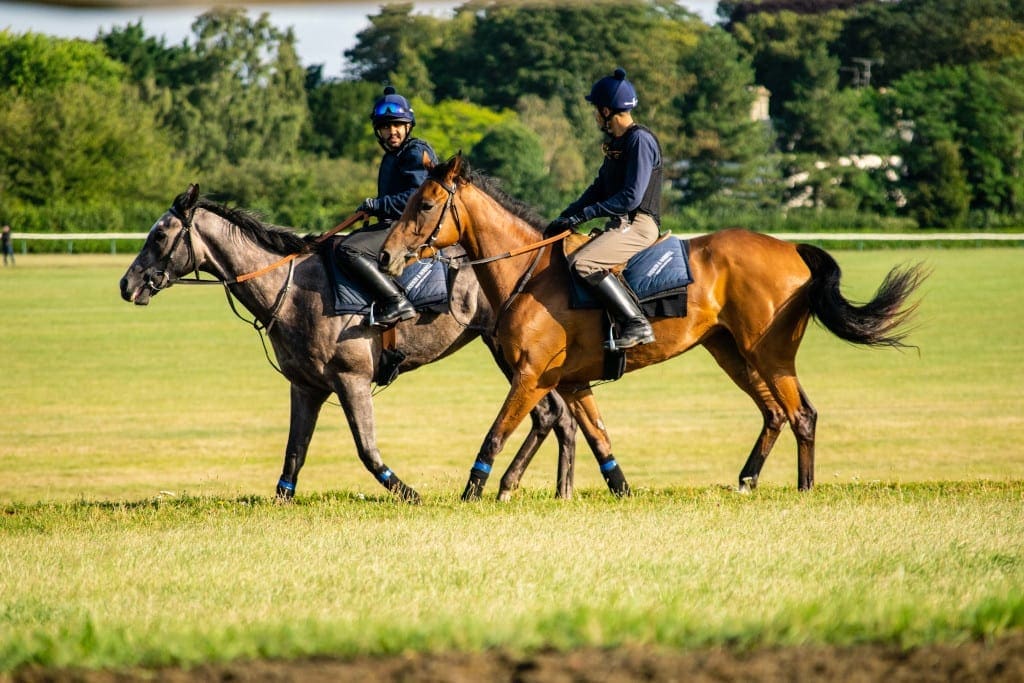
The National Stud, Jockey Club Newmarket
The pace was quieter on the second leg of our tour at The National Stud, an integral part of the British Thoroughbred industry which has been owned by The Jockey Club for the last ten years.
Mainly due to investment from overseas breeders, the quantity and quality of stallions based in Newmarket has increased markedly in recent decades. There are now over 40 of them ‘working’ in the area, including the much-sought after Dubawi (an unbeaten two-year-old, winner of the Irish Guineas and much else) and the legendary Frankel, unbeaten in his fourteen races and rated by many as the greatest racehorse of them all.
These giants of the course were cossetted and bedded down in their comfortable stables and elsewhere as the rain began to sweep down on Newmarket racecourse. But wandering around part of the 500-acre National Stud estate we encountered two of the magnificent ‘resident’ stallions Aclaim and Rajasinghe, rugged up but looking lively in their large paddocks despite the inclement weather. You certainly wouldn’t offer your hand to these two for a nuzzle.
The Mating Game
After a walk past the cemetery where the great Mill Reef is buried, we retreated to the shelter of the “covering barn”, where Frankie, our extremely knowledgeable guide gave us a fascinating and detailed lecture on how this very public act of mating takes place.
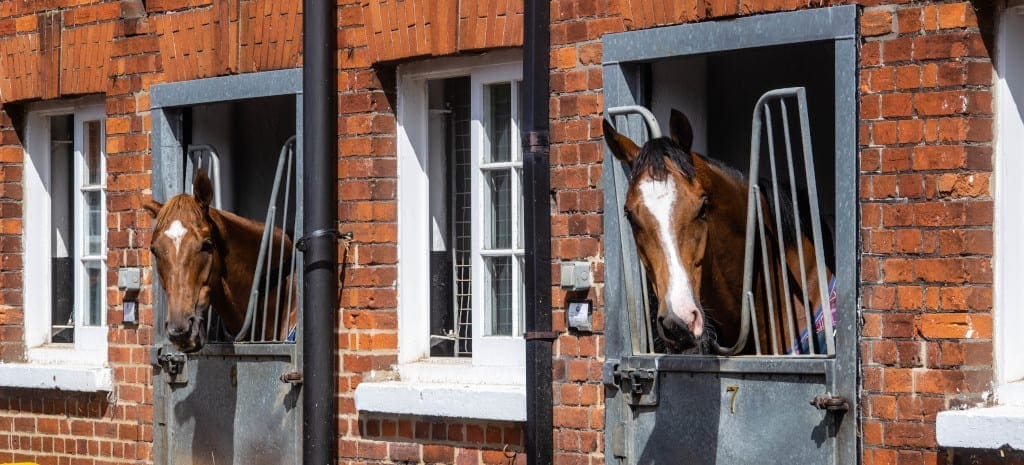
The mare is ushered in through a back entrance – perhaps with her foal from the previous season for company, while a ‘teaser’ stallion is on hand to get her in the mood. Then, there’s the phalanx of trainers, vets and assorted helpers to make sure the encounter – which lasts just a few minutes, after which the two animals never see each other again – runs as smoothly as possible.
In the breeding season the stallions are brought to the covering barn four or five times a day. This is a multi-million business – at the top end of the scale, the likes of Dubawi and Frankel can command a covering fee of approaching a quarter of a million pounds.
Waxing About Lyrical
Part three of the tour was the aforementioned visit to Lyrical and her fellow ninety companions at La Grange stables on Fordham Road. There’s great history here, with a Grand National winner in 1923 (Sergeant Murphy) and more recently, under current trainer Ed Dunlop, star horses such as Snow Fairy (Oaks winner) and Trip to Paris (Ascot Gold Cup 2015).
Through the enthusiastic Scott, we gained great insight into the working day of a top-notch racing yard. We were shown the tack room with its elegant wood-paneled walls, the covered ride with two horse-walkers and – most interestingly – the Water Treadmill, an innovative piece of equipment which helps an animal recover from ankle, shin and knees injuries as well as improving its general level of fitness.
The Newmarket Races
Our Discover Newmarket morning tour had given us the perfect introduction into the evolution and preparation of a racehorse. Now it was time to watch them in action, so off we went to the Rowley Mile course for the final meeting of the season. We had missed Lyrical, but there were still six races on the card on which to squander our money.
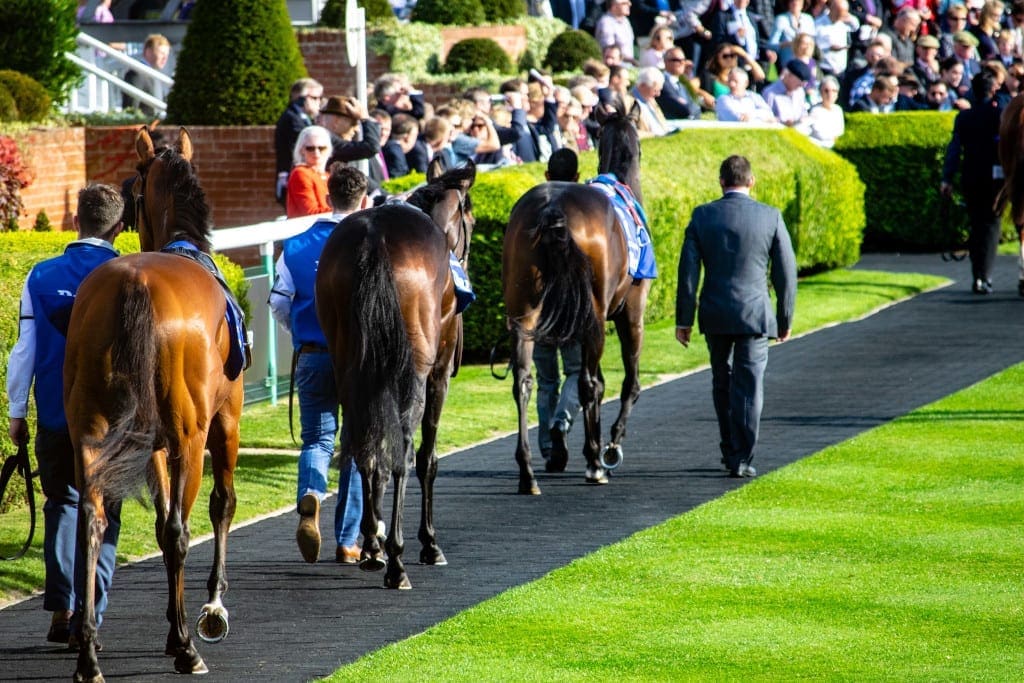
For occasional racegoers like ourselves, the fun begins at the parade ring, where, formbook in hand, you study the competitors and make an assessment based on whim and instinct. The semi-educated guesswork invariably fails, but the delight is great when it succeeds.
It was starting to look like one of those spendthrift days as our picks struggled in the heavy going. But just as we were escorted into the Royal Box, and glasses of champagne thrust into our hands, our luck turned. There is nothing quite like backing a winner who ghosts through the field in the final furlong, and so it was with the American colt Kensai Warrior in the 2.05 – earning its owner £22,000, and us £32 on an each-way bet.
Staying at the Jockey Club Newmarket
Feeling like kings, we headed off to the Jockey Club Chambers (bedrooms to the uninitiated) where we would be eating, and sleeping, that night. Appropriately, we were fortunate to be able to check into the magnificent Royal Suite in which – a plaque on the wall informs you – their majesties King Edward VII and King George V stayed during race meetings between 1881 and 1935.
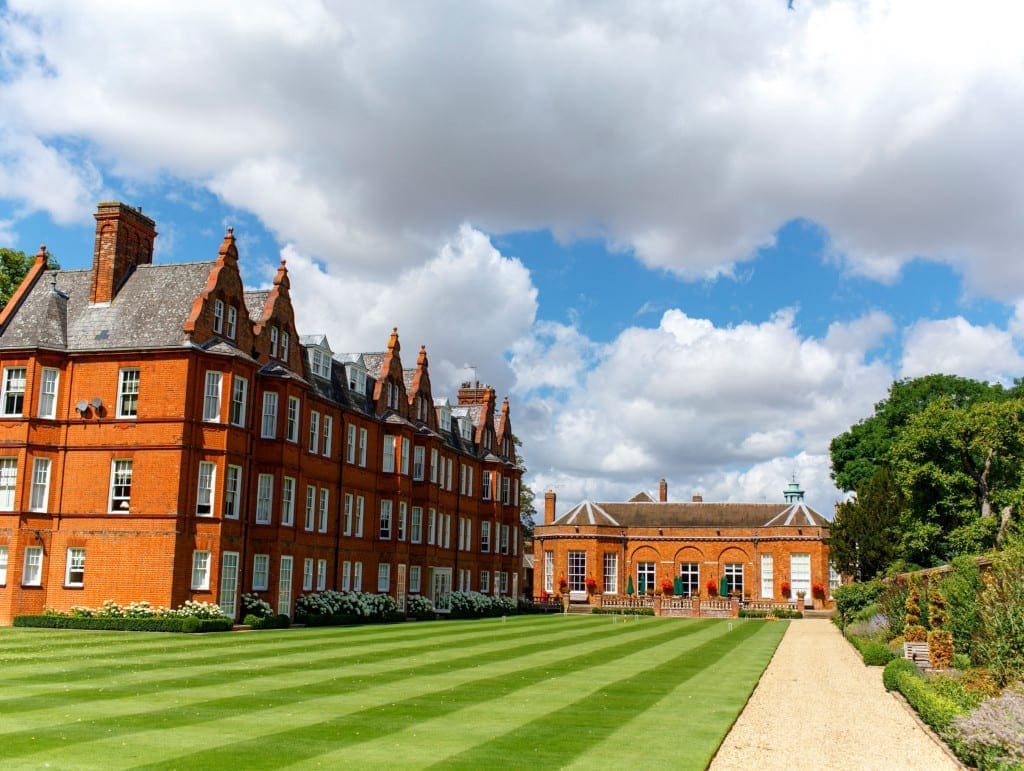
This was a magnificent set of rooms, with luxurious four-poster bed, supremely comfortable sofa and armchairs in a separate sitting room, and quite possibly the longest and deepest bath either of us had ever seen. In keeping with the royal theme and amongst the many superb paintings, two cartoons adorned the wall of the sitting-room, one depicting the Queen offering a gloved hand to a favourite horse, and the other picturing her father with the great jockey Sir Gordon Richards.
In all there are eighteen rooms at this private club which has ruled British horseracing since the 1750s. It is built on the site of the original Coffee Room where the founders first gathered to place bets, and although the current building dates only to the 1930s, the elegant interiors hark back to a much grander age.
Leaving the Royal Suite for dinner was like stepping into our very own art museum. The Jockey Club boasts the finest collection of equine paintings you will find probably anywhere in the world, together with portraits of the politicians, aristocrats and various members of the racing fraternity who have been connected with the organization over the years.
For example, countless Derby winners stare down from the walls of the Dining Room. Then in the Morning Room and the Card Room there are masterpieces by Stubbs – ‘Eclipse’ and a version of ‘Gimcrack’ – while Alfred Munnings’ 1921 painting of ‘Buchan’, a champion sire owned by club member Lord Astor, also hangs here.
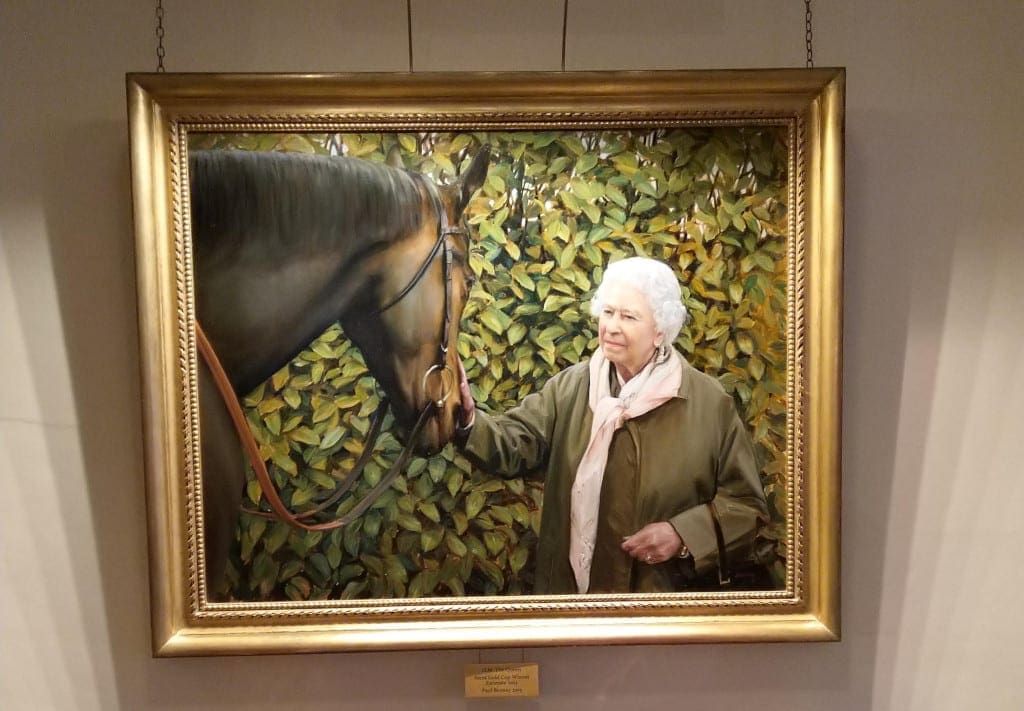
There’s a splendid – if somewhat flattering – portrait of Winston Churchill, a great lover of the sport, painted in 1953 when he was Prime Minister by Britain’s ‘Painter Laureate’ Frank Salisbury; the great man looks about fifty rather than 80. Nearby modern artist Paul Benney has two delightful offerings – The Queen with her Gold Cup winner Estimate, and Sheikh Mohammed bin Rashid al Maktoum with his favourite Dubai Millenium.
Then under the benign gaze of Lord Rockingham, a lesser-known Whig Prime Minister but one of the founders of the Jockey Club, we sat down to a sumptuous seven-course dinner with tasting wines. Roasted pumpkin, poached oysters, beetroot pickled mackerel (with white chocolate and horseradish puree), gingerbread coated venison leg – and a good deal else. A memorable culinary experience.
Palace House
We still hadn’t quite had our fill of the equine extravaganza. Final stop on Sunday morning was Palace House, the National Heritage Centre for Horseracing and Sporting Art, situated on the former site of the sporting palace and stables of the only monarch ever to have won a horse race – Charles II.
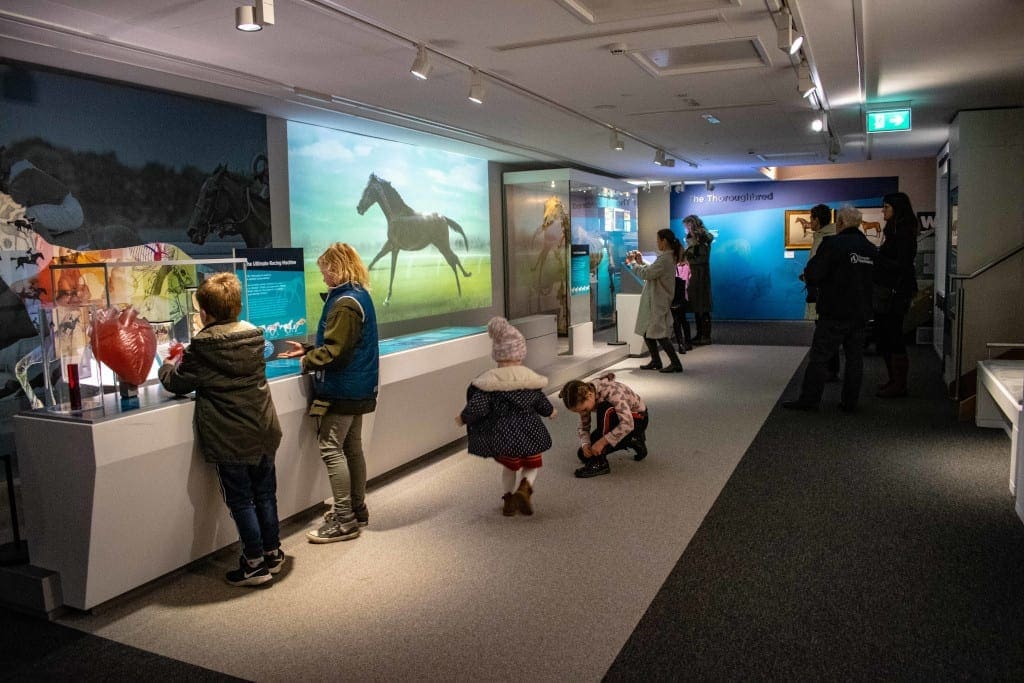
Opened by The Queen three years ago, this five-acre site (accurately branded as ‘more than a museum’) comprises three complementary attractions: a new National Horseracing Museum, a National Art Gallery of British Sporting art, and the opportunity to meet former racehorses under the care of the charity the Retraining of Racehorses.
It’s the biggest new attraction to open in Suffolk in the last decade, and really needs most of a day to do it justice. We enjoyed getting to know the horses in the resplendent Rothschild Yard, before receiving a hugely informative lecture in the stand of the Peter O’Sullevan Arena (named after the great BBC commentator).
But it was the museum itself, with its galleries of artefacts and curiosities, that stoked the imagination. Here you can learn about bloodlines and equestrian science, but also find the stuffed and mounted head of Persimmon, winner of the Derby in 1896 – almost certainly the first major horse race captured on film. There seem to be bits of poor old Persimmon all over Newmarket – one of his hoofs was turned into an ashtray and resides back at the Jockey Club.
Newmarket Races Photo Gallery
In a case nearby, continuing the macabre theme, is the six-chambered revolver with which Fred Archer, champion jockey for thirteen successive seasons, took his own life. Archer, five foot ten, waged a continual battle to make the weight although he was finally worn down by illness and personal tragedy.
On the other side of the room the story is told of the fascinating life of Lord George Bentinck, an aristocratic dandy and inveterate gambler, but also a man, to his credit, who helped rid racing in the 1830s of all-too-common corruption which saw doping, bought jockeys, bribed officials, false starts and ‘ringers’.
“The history of mankind is carried on the back of the horse” – to quote that well-known writer Anonymous. We departed Palace House having thoroughly enjoyed our thirty-six hours of travel down the ages in the sport of kings.
Newmarket Travel Tours
Details of the Ultimate Newmarket Experience and other tours and events offered by Discover Newmarket travel company can be found here.
Newmarket Hotel
The Jockey Club Newmarket has B&B rooms from £150.
